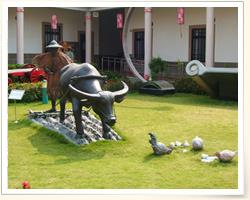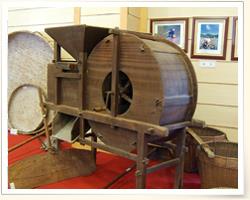
Hakka Cultural Museum
Among the 2.76million citizens of Kaohsiung City, about 0.4Million (or 14%)is of Hakka origin, and most of them came from Taioyuan, Hsinchu, Miaoli, Dongshih in Taichung County, Meinong, Panting, and Fukien and Guangdong Areas. Even though they are few in numbers, recently this group of people has been highly recognized by the Taiwan government. In hopes of preserving the Hakka culture, Mayor Wu, Den-Yih of Kaohsiung Government planned to build Hakka Culture Museum on the grounds on Tongmeng 2nd Road in Sanmin District (2nd Park)covering an area of 500pings above ground and 300pings underground in 1995 at the cost of NT$70 million. The building was completed in November1998. The exhibition pieces were donated by Kaohsiung Bao Chung Royal Guard Temple, the faith center of Hakka. The pieces include tools and instruments for production and transportation in ancient farmers, the daily household utensils, ritual ware in marriage and funerals, plus some old building materials and photos showing Hakka relics. In addition to exhibiting and preserving the cultural pieces of the Hakka people, the Museum provides a ground for culture and history lovers as well as students for their studies, so as to extend and expand the influence of the Hakka culture.
(For detail, see the description plaque inside the museum.) Also to Cooperate with the 2nd phase of the construction of “Kaohsiung City New Hakka Culture Park”, which is expected to be finished by May 2009,the current “Hakka Culture Section” will be re-designed as “Hakka Culture Center”.
Hakka Library
In March, 2003, in order to strengthen the promotion of Hakka cultural affairs, Mayor Frank Hsieh, despite tight budgeting, managed to appropriate money for the establishment of Hakka library. In addition to preservation and display of the original artifacts in the Kaohsiung, Hakka Culture Museum, this library has been established to strengthen the Hakka culture and make available Hakka literatures, history records and other additional materials and equipment for research into the Hakka culture. This move has provided added functions to the original mission of Hakka Culture Museum.
At the Library, in addition to the collection of various Hakka literatures, publication and local historical records, a unique treasure called the, “Pedigree of 100 Odd Family”, is available for studying the origins of various families for several ethnic groups in Kaohsiung, not limited to the Hakka people.
We hope that our offers and services will meet the needs of all interested parties, and we welcome any suggestions that may be used to enrich and better our services.

Museum of Historical Relics
Central China is where people originated. With five major migrations in the past, Jiayingzhou of Guangdong Province has become the second native place for the Hakka people in Taiwan. Jiayingzhou has currently changed its name to Meizhou City, with jurisdiction over seven municipalities such as Mei Xian, Jiao Ling, Ning, Wu Hua, Ping Yuan, Da Pu, and Fengshun. Following the migration of the Fukkienese, a large Hakka population migrated to Taiwan during the reign of Emperor Kangxi of the Ching Dynasty.
Good morals such as loyalty ad filial devotion to family, industriousness and thriftiness, as well as sincerity are the hereditary features of Hakka Culture. The museum is decorated in the traditional Hakka style. The museum presents various historical relics such as agricultural facilities. Daily used articles, folk customs, etc.
After the establishment of the museum, many citizens, school and kindergarten pupils came and visited the museum. The museum has even attracted various Taiwanese social organizations, as well as overseas visitors, to visit and gain a greater understanding of how the ancient Hakka people progressed, and at the same time to appreciate the beauty of Hakka traditions.